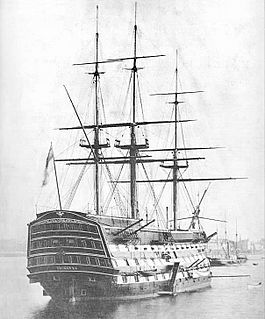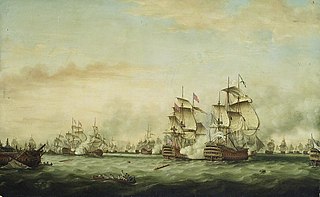
In the rating system of the British Royal Navy used to categorise sailing warships, a first rate was the designation for the largest ships of the line, equivalent to the 'super-dreadnought' of more recent times. Originating in the Jacobean era with the designation of Ships Royal capable of carrying at least 400 men, the size and establishment of first-rates evolved over the following 250 years to eventually denote ships of the line carrying at least 80 guns across three gundecks. By the end of the eighteenth century, a first-rate carried not less than 100 guns and more than 850 crew, and had a measurement (burthen) tonnage of some 2,000 tons.

Greyhound Lines, Inc., usually shortened to Greyhound, is an intercity bus common carrier serving over 3,800 destinations across North America. The company's first route began in Hibbing, Minnesota in 1914, and the company adopted the Greyhound name in 1929. Since October 2007, Greyhound has been a subsidiary of British transportation company FirstGroup, but continues to be based in Dallas, Texas, where it has been headquartered since 1987. Greyhound and its sister companies in FirstGroup America are the largest motorcoach operators in the United States and Canada.
Sixteen different ships of the British Royal Navy have been named HMS Greyhound, after the greyhound, a breed of dog notable for its speed.
HMS Fame was a 74-gun third-rate ship of the line of the Royal Navy, in service during the Seven Years' War and the American Revolutionary War.

HMS Bristol was a 50-gun Portland-class fourth-rate ship of the line, built for the Royal Navy in the 1770s. She served as a flagship during the Battle of Sullivan's Island, Charleston, South Carolina in 1776 during the American Revolutionary War and later participated in the 1783 Battle of Cuddalore during the Anglo-French War of 1778–83. By 1787 the ship had been converted into a church ship. Converted into a prison ship in 1794, Bristol instead served as a hospital ship until she was broken up in 1810.
HMS Arrogant was a 74-gun third rate ship of the line of the Royal Navy, launched on 22 January 1761 at Harwich. She was the first of the Arrogant class ships of the line, designed by Sir Thomas Slade.

The Barfleur-class ships of the line were a class of four 90-gun second rates, designed for the Royal Navy by Sir Thomas Slade.

The Royal Oak-class ships of the line were a class of six 74-gun third rates, designed for the Royal Navy by Sir John Williams. The Alfred class were an enlarged version of the Royal Oak class.
HMS Gloucester was a 50-gun fourth-rate ship of the line built for the Royal Navy in the 1710s. She participated in the 1701–15 War of the Spanish Succession. The ship was burned to prevent capture after she was damaged in a storm during Commodore George Anson's voyage around the world in 1742.
HMS Bristol was a 50-gun fourth rate ship of the line built for the Royal Navy in the first decade of the 18th century.
HMS Eagle was a 58-gun fourth rate ship of the line of the Royal Navy.
HMS Tavistock was a 50-gun fourth rate ship of the line of the Royal Navy, built at Kingston upon Hull to the draught specified in the 1745 Establishment, and launched on 26 August 1747.
HMS Falmouth was a 50-gun fourth rate ship of the line built for the Royal Navy during the 1750s. She participated in the Seven Years' War and was badly damaged during the Battle of Manila in 1762 and was abandoned as unseaworthy in the East Indies in 1765.

HMS Halifax was a schooner built for merchant service at Halifax, Nova Scotia in 1765 that the British Royal Navy purchased in 1768 for coastal patrol in North America in the years just prior to the American Revolution. She is one of the best documented schooners from early North America.
The Greyhound class was a development of the Cruizer-class sloop, and comprised two 17-gun wooden screw sloops. They were both launched in 1859 and saw service with the Royal Navy until 1870. The class was reclassified as corvettes in 1862.
James Macnamara was an officer of the Royal Navy who served during the American War of Independence and the French Revolutionary and Napoleonic Wars.
HMS Trial or Tryall was a 10-gun two-masted Hind-class sloop of the Royal Navy, designed by Joseph Allin and built by him at Deptford Dockyard on the Thames River, England. She was launched on 17 July 1744. She and her sister ship, Jamaica, were the only sloops to be built in the Royal Dockyards between 1733 and 1748.

The Skirmish of Loch nan Uamh was a conflict that took place on 2 May 1746 and was part of the Jacobite rising of 1745. It was fought by the British Royal Navy against French privateers who were supporting the Jacobite rebels.
Bellone, was a French privateer. Bellone was involved in a naval battle in Loch nan Uamh during the Jacobite rising. She was captured in 1747. She taken into Royal Navy service as HMS Bellona and was sold in 1749.









